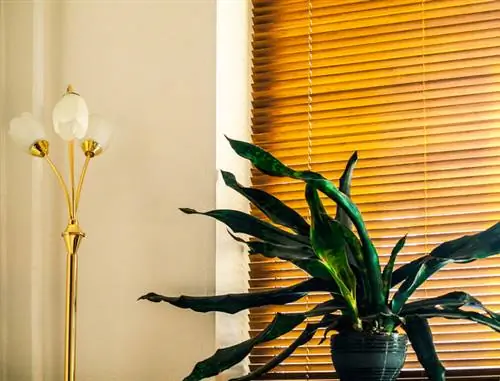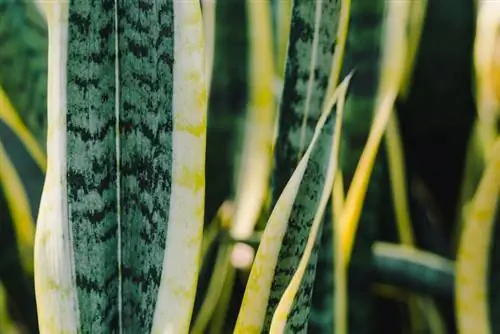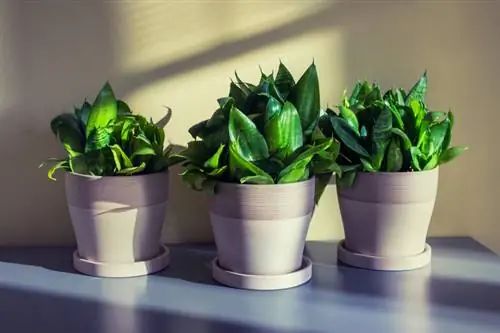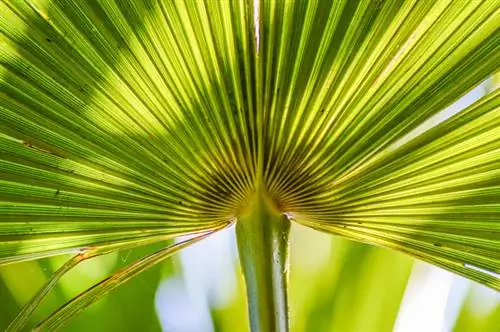- Author admin [email protected].
- Public 2023-12-25 17:45.
- Last modified 2025-01-23 11:19.
Bow hemp (bot. Sansevieria), also known as mother-in-law's tongue because of its up to one meter high and pointed leaves, is one of the most popular houseplants in German living rooms. Having been established on window sills for decades, the plant has once again gained popularity due to its many positive properties: Not only are the different varieties extremely easy to care for and require little, bow hemp is also considered a biological air purifier. In fact, it is recommended to place the plants in the bedroom or living room, as they filter toxic substances from the surrounding air and instead release more oxygen.
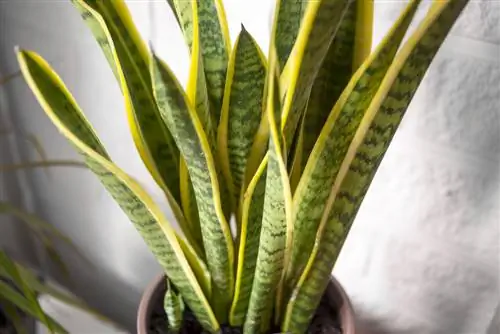
How do I care for bow hemp properly?
Bow hemp is easy to care for. Water the houseplant moderately and avoid waterlogging. Place the bow hemp in a semi-shady place in the apartment and ideally water it every 7 to 10 days.
Origin and distribution
The arched hemp has been a popular and easy-care houseplant in German living rooms for decades. Its botanical name, Sansevieria, is a reference to the famous Italian nobleman and patron of science Pietro Antonio Sanseverino (1724-1772), who cultivated the exotic plants in his garden as early as the 18th century. Today bow hemp is still widespread in many gardens in southern Europe and on the Mediterranean islands, but it also occurs in wild form.
The plant, also jokingly known as “mother-in-law’s tongue” because of its pointed leaves, comes from the dry, warm climate of the tropical regions of Central and East Africa, where numerous species are at home, especially in the deserts of Kenya and Tanzania. A few of the total of 67 species also occur in tropical Asia, especially in India, Myanmar and Sri Lanka. Many Sansevieria species have fibrous leaves, which have long been an important raw material for making baskets, mats and other wickerwork, as well as ropes, bowstrings and clothing. The German name “Bogenhanf” refers to this purpose, although the importance of the plant has declined significantly since the triumph of various synthetic fibers.
Today, from a botanical point of view, the genus Sansevieria is classified in the asparagus family (Asparagaceae) and is closely related to the Dracaena (dragon tree), although it does not belong to it. Because of the superficial visual similarity, arched hemp was previously considered a member of the agave family (Agavoideae), but this has not been scientifically confirmed.
Usage
As a tropical desert plant, Sansevieria is not frost-hardy in this country and can therefore only be cultivated as a houseplant. However, in regions with a more favorable climate, for example in the Mediterranean and in the south of the USA, the plant is also very popular in the garden. Here, for example, its use as a kind of property boundary is widespread.
In Africa, the fibrous leaves of some species of bow hemp are used to make baskets, mats, bowstrings, ropes and even clothing. This is also referred to by the alternative name “African sisal”, which is still used today to advertise certain handicraft products. Other species such as Sansevieria Ehrenbergii were and are used in folk medicine in some regions and countries in Africa because of their antiseptic ingredients, for example to treat ulcers and skin rashes.
Appearance and growth
The Sansevieria species we cultivate as houseplants - Sansevieria trifasciata and Sansevieria cylindrica - do not form a trunk. Instead, they are perennial, evergreen succulents whose fleshy leaves emerge directly from the underground rhizomes. Over time, the plants form increasingly extensive clumps which, if not repotted regularly, can even burst the planter. The above-ground runners, through which the arched hemp practically reproduces itself, are also typical.
leaves
Typical of the leaves of the species Sansevieria trifasciata are the, depending on the species, more or less, wide, tapered and thick-fleshed leaves. These are either arranged like a rosette or grow tightly upright. The different varieties of Sansevieria cylindrica, on the other hand, have round leaves that are up to 150 centimeters long. With regard to the numerous variations in leaf markings, the approximately 70 varieties are very diverse: In addition to varieties with plain dark green leaves, there are numerous forms with yellow, light or dark green cross bands as well as those with mottling in different shades of green.
Flowers and fruits
If the arched hemp is well cared for according to its needs, it sometimes develops a flower after a few years. The sweet-smelling, greenish-white flowers are arranged like panicles on a short stem and only open at night. In nature, pollination is carried out by moths, which of course do not go to waste in this country. For this reason, seeds that would otherwise form in the orange to red berries of the Sansevieria usually do not develop. After flowering, the flower-bearing shoot dies, but not the plant. Flowers on arched hemp are very rare in indoor cultivation and are therefore always a special feature.
Toxicity
In particular, Sansevieria cylindrica, which has become increasingly popular as a houseplant in recent years, contains toxic saponins and should therefore be kept away from small children and pets - especially cats, dogs and rodents such as guinea pigs and rabbits. Poisoning, for example caused by eating the thick leaves, typically manifests itself as nausea, combined with cramps, vomiting and diarrhea. In the event of poisoning, give the affected person plenty of water (non-carbonated and under no circumstances milk!) to drink and consult a doctor or veterinarian immediately.
Which location is suitable?
The arched hemp thrives best in locations that are as sunny and warm as possible, for example directly next to a south-facing window. The distinctive leaf patterns of many varieties only develop when there is sufficient light, while the leaves quickly turn dark green in dark locations. However, make sure to slowly acclimate the plant to direct sun - especially midday sun - otherwise there is a risk of leaf burns. However, the undemanding Sansevieria also thrives in shadier and cooler places, but then grows much more slowly.
As a desert dweller, the Bogenhaft tolerates drought and cooler temperatures very well, although these must not fall below 12 °C. However, the plant feels most comfortable in a warm and humid environment, which is why many people like to place bow hemp in the bathroom or kitchen. During the warm summer months you can cultivate the plant on the balcony or terrace - of course with an appropriate, slow acclimatization to the new location - but you should bring it in in good time in early autumn and in cold and rainy weather conditions.read more
Substrate
As a desert plant, arched hemp prefers a rather dry, well-drained and mineral substrate. Cactus soil is very suitable, as is an unmixed mix of compost soil and a third of sand or gravel. If possible, add perlite, puffs or other clay granules, etc. to this mixture to improve permeability. However, commercially available potting soil or green plant soil is less suitable, even if the arched hemp - adaptable as it is - will grow in it. Garden soil is also not suitable. However, sansevierias are grateful candidates for hydroponics, for which you should choose a small to medium-sized grain size.
Planting bow hemp correctly
Since the leaves of the Sansevieria can grow between 100 and 150 centimeters high, they often reach a corresponding weight. These tall-growing varieties become quite top-heavy over the years, which is why you should place them in planters made of heavy materials - such as clay or ceramic - to protect them from tipping over. In addition, the pots should have as wide a diameter as possible, as the thick rhizomes of the sansevierias spread out close to the surface of the substrate. The vessel can also be rather flat.
When planting bow hemp, it is important to ensure good drainage in the pot, as the desert dweller has difficulty withstanding constant moisture and especially waterlogging. The planter must have a sufficiently large drainage hole at the bottom and must also be on a saucer or in a planter. Excess irrigation water can drain here, which you can remove quickly after watering. Cover the drainage hole with a few shards of clay to avoid clogging due to muddying and also place a thin layer of gravel or a layer of clay granules. Only then fill in the substrate.
Repotting
You can tell when the time is right for repotting sansevierias not only by the roots growing out of the pot, but also by the occasional bending of the leaves - these break because their rhizome is no longer sufficiently anchored in the substrate for a firm hold. If the plant does not yet need a larger container or is already in a large pot, replace the top layer of substrate every year. The best time for repotting is spring between March and April.read more
Watering bow hemp
Sansevierias have thick, fleshy leaves that store a lot of water and prepare the succulent plant perfectly for longer dry periods. For this reason, bow hemp tolerates drought excellently, but persistent moisture or even waterlogging has difficulty or not at all. Therefore, the plants should only be watered a little and dried thoroughly every now and then. Water during the growing season so that the substrate is well moistened. The root ball can then be allowed to dry out; this will not harm the plant at all. In the winter months, however, watering is only done sipwise. At any time of the year, measure the right time for watering with the help of your index finger: stick it into the substrate and feel its moisture. If the soil is already dry at a depth of a few centimeters, you can add water again.
When watering, be careful not to wet the leaves. Rot quickly occurs, especially when water collects in the leaf rosettes. Incidentally, overwatering quickly becomes apparent in soft leaves and/or rotten areas. A moldy smell coming from the pot indicates root rot has already occurred.read more
Fertilize bow hemp properly
Reserve is required not only when watering, but also when fertilizing. Too much fertilizer also causes soft leaves, which then quickly bend and/or break off. Yellowish to brownish discoloration is also not uncommon in this case. Fertilize the bow hemp at most once a month between April and August, ideally using a low-dose cactus fertilizer. Halve the amount specified in the manufacturer's application instructions, because sansevierias do not have a high nutrient requirement and can get by with significantly less. Use a liquid fertilizer that you give along with the irrigation water. Never fertilize on dry substrate as this can cause root damage. In the remaining months between September and March, however, there is no fertilization and only little watering.
Cut bow hemp correctly
Some types and varieties of arched hemp can have leaves that are quite tall at 100 to 150 centimeters and therefore become too large for the windowsill. However, the plants grow very slowly, so it can take a few years until they reach an appropriate size. If you still want to be on the safe side, choose a low-growing variety such as Sansevieria trifasciata Hahnium.
Cutting back the leaves of arched hemp is definitely not recommended, because the corresponding shoots will not sprout again. Instead, an unsightly edge remains that turns brown. Such a cut also represents an entry point for fungi and other pathogens, so that the plant not only loses its visual appeal. However, instead of leaf pieces, whole leaves can be cut off close to the substrate base, for example to remove brown and dried leaves or to obtain cuttings.
Propagate bow hemp
Sansevierias can be propagated quite easily by leaf cuttings and, in the case of large plants, by division.
Propagation by cuttings
When propagating arched hemp cuttings, you need patience, because the slow growth of the plant means that it takes a few years until an attractive plant is created. However, it is also a lot of fun to raise the tiny little one yourself right from the start. And this is how it works:
- Cut off an entire leaf just above the ground.
- Cut this evenly into approximately ten centimeter pieces.
- Make a mark for “top” or “bottom” with a pen.
- Dip the bottom cut edge into a rooting powder.
- Place the cuttings with the lower edge several centimeters deep in a growing substrate.
- Place the growing pot in a bright and warm, but not directly sunny location.
- Keep the substrate evenly moist, but not wet.
- “Tense air”, i.e. H. a foil cover or similar is not necessary.
After a few weeks, the cuttings develop the first roots, and a little later the first offshoots appear. Now you can remove the leaf piece as the actual plant grows out of the resulting rhizome. By the way, you should always propagate variegated varieties by division, as their cuttings usually develop monochromatic green leaves.
Reproduction by division
Specimens that have become too large can be divided without hesitation, which is best done in conjunction with a repotting that is due anyway. Have a separate pot with suitable substrate ready for each new individual plant. This is how sharing works:
- Lift the bow hemp out of the planter.
- Carefully remove the substrate from the roots.
- Look for small side shoots or offshoots or secondary rosettes that should preferably be divided off.
- If necessary, cut it off from the mother plant using a sharp and disinfected knife.
- If the plant is still too big, you can divide it completely.
- Each rhizome piece should have at least one shoot, preferably more than two.
- Plant the sections separately immediately after dividing.
- You can use cactus soil or a soil-sand mixture.
A rooting powder is not necessary in this case, after all, the sections are already rooted. Otherwise, care for the new Sansevieria like the adult bow hemp.read more
Wintering
Since arched hemp is not winter hardy, it must overwinter frost-free. If possible, it does this at around 13 to 16 °C and with very sparing watering. Of course, you can continue to cultivate the succulent in the warm living room, but the plant survives the low-light period best in a cooler room. During this time the bow hemp stops growing. As soon as the days become longer again in spring and the hours of sunshine increase, gradually increase the temperature and watering.
Diseases and pests
Sansevierias are very robust plants that only become ill due to serious care errors. A pest infestation, however, is rare, but can occur. Mealybugs and spider mites in particular occur occasionally, although you should avoid showering affected plants if possible.
- brown discolored / soft leaves: root rot due to waterlogging, but also temperatures that are too low
- yellow discolored / limp leaves: overwatering or overfertilization
- brown spots on the leaves: drought
- moist, soft spots on the leaves: fungal attack
If the arched hemp is infected by a fungus and its leaves become soft as a result, the plant can usually no longer be saved. However, you can cut off the tips of the leaves and use them as cuttings for new plants.
Tip
As a gift, bowed hemp has a rather bad reputation in this country, which is not least due to its nickname “mother-in-law's tongue”. In fact, it is an easy-care plant that also improves the air in the room and is therefore a great souvenir. In this case, point out the numerous advantages of the houseplant and mention, especially to your mother-in-law, that this is by no means a nasty innuendo.
Species and varieties
The species Sansevieria trifasciata has been cultivated as a houseplant for many decades; there are numerous ornamental forms of it in different heights, growth types and leaf colors. In addition to the green-leaved forms, the subspecies laurentii, which has broad, light yellow-edged leaves, is particularly popular. This species can grow quite tall with heights of more than one meter, while the varieties of the subspecies Sansevieria trifasciata hahnii remain comparatively small with an average height of up to 20 centimeters. Hahnii forms also come in very different colors.
Sansevieria cylindrica, with its rounded, column-like, upright leaves, is still relatively new as a houseplant. This breeding form also remains quite compact and is therefore ideal for the home windowsill. The leaves of this species are often offered in a braided form, which does not correspond to the natural growth habit. There are also some interesting ornamental forms of the rare Sansevieria kirkii, which has very narrow and rather short leaves.


